
* In addition to the nations that license-built the Starfighter, the F-104 was exported to a number of countries under the US Military Assistance Program. This chapter completes the discussion of the F-104's foreign service. It also discusses its use in civilian hands, and describes a number of unbuilt Starfighter variants.
* Beginning in 1963, Norway acquired a batch of 21 new-build Starfighters, including 16 Lockheed-built RF-104Gs, 3 Canadair-built CF-104s, and two CF-104Ds. These deliveries were followed by two ex-Luftwaffe TF-104Gs from the Luftwaffe training center at Luke AFB in the US. A final batch of 20 ex-Canadian Armed Forces Starfighters, including 18 CF-104s and 2 CF-104Ds, was obtained in 1973, with the single-seaters kitted out for carriage of the Bullpup missile for anti-ship strike. That gave a total force of 43 Starfighters, including 37 single-seaters and 6 two-seaters.
The initial batch of Norwegian F-104s was originally flown in natural metal, with the aircraft gradually painted overall anti-corrosion light gray. All Canadian machines retained their overall green color scheme. All Norwegian Starfighters were retired in the early 1980s, to be replaced by the F-16. Some of the surviving F-104s were passed on to Turkey. The Norwegians only lost six of their Starfighters in accidents despite the relatively harsh climate, giving a reasonable loss rate of 13.6%.
* Denmark received an original batch of 25 Canadair-built F-104Gs and 4 Lockheed-built TF-104Gs beginning in 1965, with these aircraft provided under MAP funding. This was followed by a batch of 15 ex-RCAF CF-104s and 7 CF-104Ds beginning in 1971, with these machines overhauled and modified to F-104G / CF-104G standard in Denmark. The overhaul was based on kits supplied by Lockheed and included replacement of the older Lockheed C-2 ejection seat with the better Martin-Baker Mark 7 seat. The Danes acquired a total of 40 single-seaters and 11 two-seaters, or 51 in all.
The Danes operated their Starfighters in anti-corrosion gray until delivery of the ex-RCAF machines, when the entire fleet was repainted in Canadian wraparound green colors. Danish F-104s served into the mid-1980s, eventually being replaced by the F-16, with survivors passed on to Taiwan. Twelve Danish Starfighters were lost in accidents, an attrition rate of 23.5%.
* Spain's air force, the Ejercito del Aire (EdA), acquired 18 F-104Gs and 3 TF-104Gs from Lockheed through MAP beginning in 1965, with the Starfighter being given the designation of "C.8" in Spanish service. They replaced the F-86 and flew in either natural metal finish or anti-corrosion gray. Service life of Spain's Starfighters was short, with the type phased out in favor of the F-4 Phantom in 1972. The Spanish aircraft ended up in the hands of the Greeks and Turks, with the total split as evenly as possible between the two rivals.
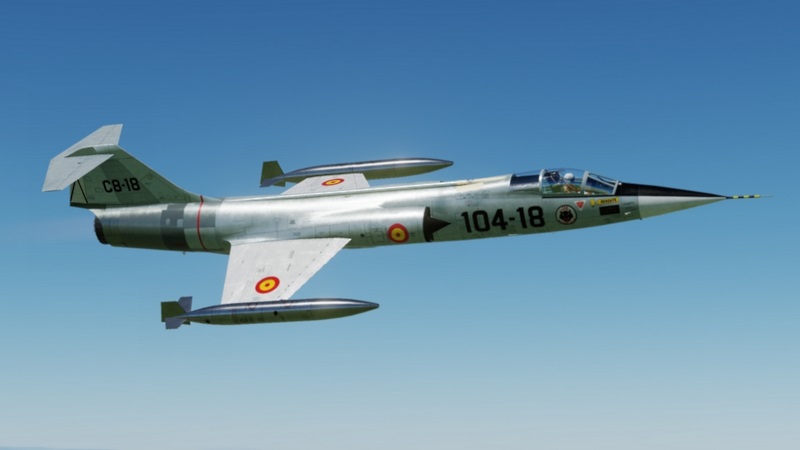
The Spaniards were relatively minor operators of the type, but they had the major distinction of never having lost one of their 21 Starfighters in an accident during seven years of operations. No doubt the generally sunny Spanish climate had something to do with it.
* Greece acquired an initial batch of 45 F-104Gs and 6 TF-104Gs under MAP funding, with these aircraft going into service in 1964. 35 of the F-104Gs were built by Canadair, while 10 of the F-104Gs and the 6 TF-104Gs were built by Lockheed. The Hellenic Air Force later acquired a large number of used machines from various sources:
This gave 57 F-104Gs, 22 RF-104Gs, and 21 TF-104Gs handed down from other air arms, or a total of 100 aircraft. Some of the hand-me-downs were mothballed to be kept in reserve, or used as spares hulks.
Greek MAP Starfighters were flown in natural metal finish, but eventually the fleet ended up being given camouflage colors, with a disruptive pattern of olive drab / dark green / sand on top and light gray on the bottom. Greek Starfighters were finally phased out of service in the early 1990s. The accident attrition rate of the F-104 in Greek service is unclear.
BACK_TO_TOP* Taiwan was a major Starfighter user, with the aircraft obtained in a complicated series of steps. Deliveries appear to have been as follows:
That gave a total of 166 single-seaters and 53 two-seaters, or 219 Starfighters in all. Not all the aircraft received were in operational condition, with some being used as spares hulks. Taiwanese F-104s were generally painted in overall anti-corrosion light gray, though a late in their careers this was modified to a two-tone subtle light gray mottled disruptive pattern.
All the early F-104A/B/Ds were withdrawn by the early 1980s, with some having earlier been sent to Pakistan in 1965 and Jordan in 1969 as discussed below. Some survived in Taiwanese service as drones or airfield decoys. The Starfighter remained in first-line service in Taiwan well into the 1990s, carrying modern AIM-9J all-aspect Sidewinders and the Taiwanese Sky Sword AAM. Apparently a few Starfighters were modified to a specialized reconnaissance specification with a long range optical (LOROP) camera in the nose.
There were plans to update Taiwanese Starfighters to the F-104 ASA standard, but it didn't happen. The last Starfighters, a handful of RF-104Gs, were retired at the end of the century. Data on Taiwanese Starfighter loss rates is unclear. It is believed they scored a few "kills" on mainlander MiG-19s during the late 1960s.
* Pakistan was an early user of the Starfighter, and one of the few nations to use the type in major combat. Pakistan initially obtained 10 ex-USAF F-104As and 2 F-104Bs in 1961, with some sources claiming these machines were re-engined with J79-GE-11A turbojets. These machines were shipped off in a hurry when it was found that India was obtaining MiG-21s, the Soviet Union's answer to the F-104. All Pakistani F-104s retained their USAF natural metal finish.
Pakistani Starfighters fought in the 1965 war with India, and the Pakistanis claim it acquitted itself well, with four kills and two losses, though Indian sources give fewer kills and higher losses. Some sources claim the Indians were very intimidated by the speedy F-104, calling it the "Badmash (Hoodlum)". Two F-104As were passed on from Taiwan to replace the losses, and there are rumors that the Pakistanis also obtained a new-build RF-104G from Lockheed production. However, after 1965 the US embargoed further shipments of Starfighters to Pakistan, and the Starfighter force withered.
Pakistani F-104s fought in the 1971 war with India as well, assisted by Jordanian Starfighters. If the Indians had indeed been intimidated by the F-104 in the 1965 war, they weren't six years later. Even the Pakistanis admitted they didn't do so well, with up to seven losses and relatively few kills. Apparently the main deciding factor was that the F-104 was simply massively outnumbered.
The Pakistanis admitted that the maneuverability of the type left something to be desired in combat, though this seems a bit puzzling. The F-104 was an aircraft suited to "hit-&-run" tactics, and was of course going to suffer in a turning fight because of its wide turn radius; why anyone would have wanted to get into a turning fight with it is hard to understand, unless it was forced on pilots by the tactical situation. Some sources claim the MiG-21 had an edge in maneuverability over the Starfighter, but the MiG-21 had been designed with roughly the same design goals in mind as the F-104, and the MiG's maneuverability was nothing to write home about, either. In any case, Pakistan finally phased the Starfighter out in the mid-1970s, replacing it with French Dassault Mirage 5 fighters.
BACK_TO_TOP* The Turks were major Starfighter operators. A portion of the Turkish fleet was new-build machines. The first batch, consisting of 44 F-10Gs, 2 RF-104Gs, and 6 TF-104Gs obtained through MAP from Lockheed and Canadair production, was delivered beginning in 1963. The second batch consisted of 40 Italian-built F-104S Starfighters, delivered in the mid-1970s.
However, most Turkish aircraft were hand-me-downs from NATO air forces, with acquisitions roughly as follows:
That gave the totals of:
-- and a final sum of 409 Starfighters in Turkish service, 92 of them new-build, 317 being hand-me-downs.
Some of the hand-me-down aircraft were overhauled before delivery, some were simply used as spares hulks. The Turks tended to keep the color schemes of the original users, resulting in a patchwork of paint jobs. Apparently Turkish Starfighters never saw any real combat. If they had, since the most probable adversary was the Hellenic Air Force, that would have led to the interesting prospect of Starfighter-on-Starfighter dogfights. Numbers of losses in accidents are unclear, but appear to have been towards the high side of the curve. The Turks retired their F-104s in the mid-1990s, the type being finally replaced by the F-16.
* In the later half of the 1960s, Jordan obtained about 18 ex-USAF F-104As and 6 ex-USAF F-104Bs, with initial deliveries just in time for the 6-Day War of June 1967. Most of Jordan's air force was destroyed on the ground during that conflict, but the Starfighters survived since Jordanian pilots didn't know how to fly them well enough at the time to use them safely in combat, and they were accordingly sent to safe haven in Turkey.
After a lapse while the aftermath of the war was sorted out, the deliveries of ex-USAF Starfighters were completed, to be followed by a batch of F-104As from Taiwan. Apparently the Jordanians were instructed by Pakistani pilots, and in return for the courtesy, as mentioned above Jordanian Starfighters fought in the 1971 Indo-Pakistan War, suffering several losses at the hands of the Indian Air Force.
Jordanian Starfighters were originally delivered in anti-corrosion overall light gray, to later acquire a dark green / olive / tan disruptive camouflage pattern on top with light gray underneath. Jordanian Starfighters were retired from operational service in the late 1970s, being replaced by French Dassault Mirage F1 fighters. Some of the old Starfighters ended up as airfield decoys, at least in some cases "dummied up" to resemble the Mirage F1.
BACK_TO_TOP* The US National Aeronautics & Space Administration was very fond of the speedy Starfighter as a flight test program, and kept it in use long after it had been phased out of general USAF service.
The NASA fleet was founded in August 1956 when the agency, then NACA, received the seventh YF-104A. This machine served NASA until 1975, when it was passed on to the Smithsonian National Air & Space Museum. This aircraft was followed by acquisition in 1963 of three new-build F-104Gs for use as chase aircraft and test platforms. These machines were given the designation of "F-104N", the "N" of course standing for "NASA". They were apparently pretty much stock F-104Gs stripped of combat gear; NASA tinkered with some of them quite a bit for special projects.
One was lost in an infamous accident on 8 June 1966, when it was being used as part of a photoshoot with a North American XB-70 Valkyrie experimental supersonic bomber. The F-104N got caught in a vortex behind the XB-70 and slammed into one of the bomber's two tailfins, tearing it off and causing the Starfighter to explode into a ball of flame. The F-104N pilot, well-known test pilot Joe Walker, was killed; the XB-70 fell to earth, with the pilot, Alvin White, surviving, while the copilot, USAF Major Carl Cross, was killed.
NASA later received two more single-seaters, it seems retired F-104Gs, as well as two ex-Luftwaffe TF-104Gs obtained in 1975. All were designated F-104Ns, no matter what actual variant they were. NASA liked to paint their aircraft in a distinctive spiffy color schemes, ultimately white overall with blue "daggers" running down each side of the fuselage. NASA retained a single-seater and a two-seater well into the 1990s.
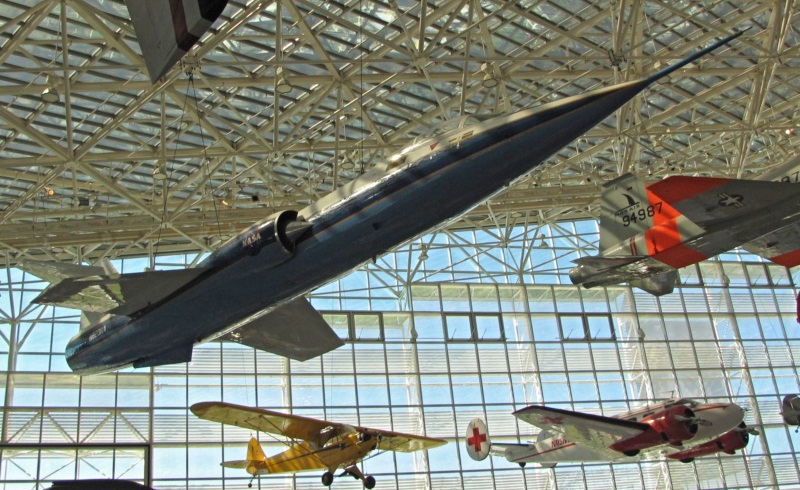
* The Starfighter established many flight records, some by civilians. Lockheed retained a single TF-104G as a demonstrator, with the aircraft given the assertive Cold War name of FREE WORLD DEFENDER. It was painted in neat overall slate-blue colors with white markings. This machine was used by aviatrix Jackie Cochrane to set three world speed records, and also used in 1963 by Tony Levier's daughter Toni to become the "world's fastest teenager". The TF-104G was later passed on to the Dutch.
Air enthusiast Daryl Greenamyer even built his own Starfighter, the bright red-and-white "Red Baron" or "F-104RB", over a 12-year period from a CF-104 airframe that he stripped of combat gear and fitted with an uprated J79 engine from a Phantom, making it a real "speed demon". On 24 October 1977, he set a world's record with the Red Baron, flying it over a frightening low-level 3-kilometer (1.86-mile) course at an average speed of 1,590.45 KPH (988.26 MPH). He was preparing for an altitude record in February 1978 when the landing gear didn't deploy properly; he punched out, and the Red Baron fell to earth.
Another civilian operator, Starfighters Aerospace, continues to fly Starfighters for NASA, being based at the NASA Kennedy Space Center in Florida, at last count had four Starfighters in service, obtained from Italy, towards a planned total of seven. They are used as test and experimental platforms; militarily, they are obsolete aircraft, but their high performance makes them very useful for NASA -- with some consideration of using them to launch microsatellites. They are painted in a variety of spiffy color schemes.
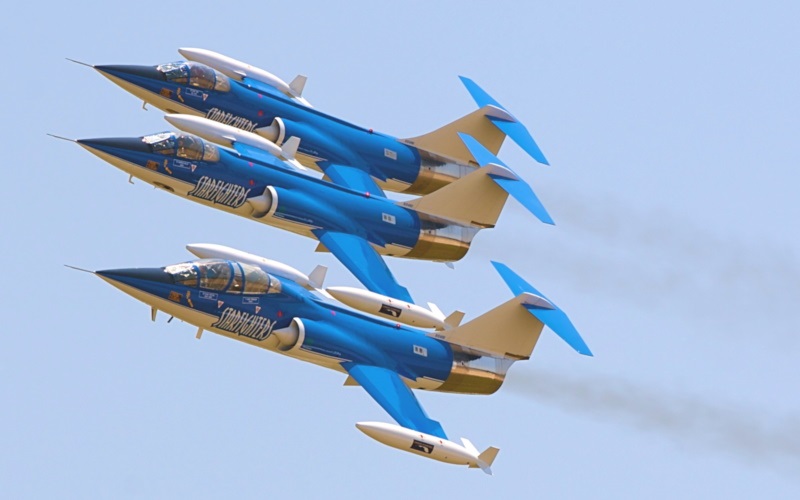
* One interesting footnote to the F-104 story is that a retired American named Ed Shadle got his hands on an old F-104A and converted it into a ground vehicle to win the world land speed record. He cut off the wings, added a forward wheel and a wheel on each side of the rear on an outrigger, with canard fins on the nose to keep the machine on the ground. The goal of the "North American Eagle", as the "car" is named, was to reach 1,290 KPH (800 MPH), breaking the current land speed record of 1,228 KPH (763 MPH), obtained by the British "Thrust SSC" in 1997. The last run was in 2008; the effort then apparently fizzled out.
BACK_TO_TOP* Lockheed of course came up with a number of proposals for different Starfighter variants that were never actually built. Some of these unbuilt machines have been mentioned previously, but there were many more.
In 1966, to counter the buildup of North Vietnamese MiG-21s, Lockheed converted an F-104C into the "CL-901" advanced air superiority configuration, with a J79-GE-19 engine, the ventral fins of the F-104S, and a variant of the F-15J NASARR radar used in Japanese Starfighters. The CL-901 performed its initial flight in September 1966 and the Air Force was interested, but decided to stay with the F-4 Phantom. Lockheed then came up with a similar "CL-934" interceptor variant and a "CL-984" strike variant, which was much like F-104S, with nine stores pylons. Belgium was interested in the CL-984, leading to discussion of a "CL-985B" variant, but discussions fell through.
The company was exploring more drastic options in parallel under the "CL-981" series of studies, envisioning such items as a stretched fuselage to provide more fuel, a bigger wing to deal with the Starfighter's high wing loading, variable-geometry canards behind the cockpit to improve the type's maneuverability, alternative powerplants, and improved avionics. These studies led to a series of other concepts with increasing model numbers, leading up to the ultimate Starfighter concept, the "CL-1200 Lancer".
The Lancer design featured a modified wing with prominent "leading-edge root extensions" that provided 50% more area and bigger flaps; a redesigned tail assembly that not only featured larger surfaces, but eliminated the tee-tail configuration, with the tailplane relocated to the fuselage; a longer fuselage with increased fuel capacity; more stores attachments; and moveable inlet cones. The initial "CL-1200-1" variant was to feature a J79-GE-19 engine, but the definitive "CL-1200-2" variant was to be fitted with a Pratt & Whitney TF30-P-100 or F100-PW-100 engine, providing about 60% more power than the GE J79, though at the expense of a "fatter" rear fuselage.
The forward fuselage remained unchanged, making it easy to modify the Lancer to the equivalent of various existing Starfighter configurations, such as interceptor, fighter-bomber, trainer, or reconnaissance variants. In the end, although the Lancer was an interesting idea, it lost out to the Northrop F-5E Tiger II. The Air Force toyed with obtaining a single modified Lancer -- with the company designation of "CL-1600" and the USAF designation of "X-27" -- as an experimental platform, but nothing came of it.
During the 1950s, Lockheed also tinkered with long-range interceptor derivatives of the F-104. The initial "CL-288" looked exactly like a stretched and beefed-up F-104, except with twin J79s, one mounted in a nacelle in the middle of each wing. The final design in the effort, the "CL-320", had much the same configuration, but was further scaled-up and had more powerful engines. The exercise never went beyond paper plans and scale models.
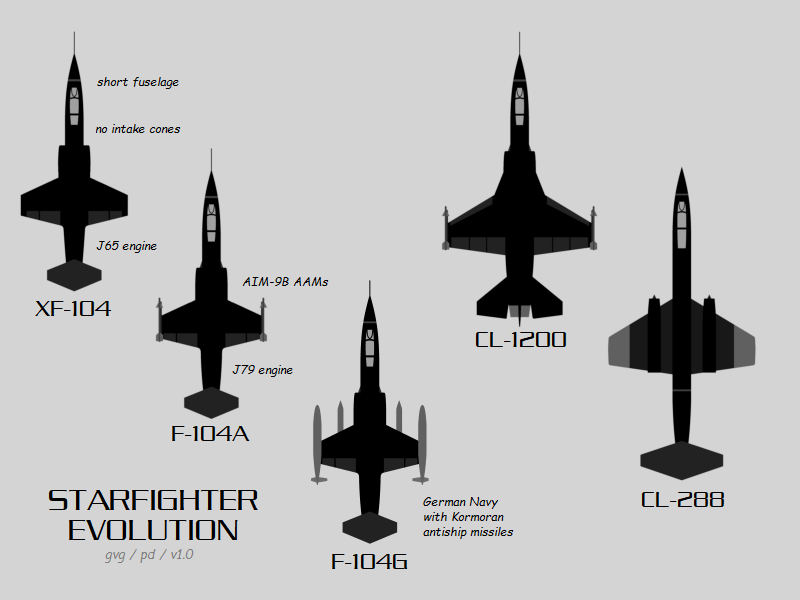
* One of the unusual variants that would actually go someplace was the "CL-282", which was proposed by Lockheed in the mid-1950s as a high-altitude reconnaissance aircraft based on the XF-104. The CL-282 was to feature very long glider-like wings and a P&W J57 engine; it was to be stripped of everything that could be removed to reduce weight, including the ejection seat. The USAF didn't bite on the idea, but the US Central Intelligence Agency (CIA) did, and approved development.
However, as the design progressed, the machine changed to the point where it had very little parts commonality with the F-104, becoming essentially a completely different design with only a general reflection of its Starfighter origins. It would emerge as the famous "U-2" spyplane, in its own way as much a part of the Cold War as the Starfighter.
* The following table provides a list of Starfighter variants and production:
That gave total production of 2,563 Starfighters.
BACK_TO_TOP* The Starfighter was a controversial aircraft in its time and remains controversial in hindsight, with some sources praising the aircraft and others damning it. It is difficult to sort through the claims and counterclaims from the sidelines, and it is also difficult to determine its actual utility as a weapon from its relatively limited combat service.
The real controversy was in its safety record, with the high accident rate being an undeniable fact. It appears that the F-104, at least after the initial bugs were worked out, was not an inherently unsafe aircraft, but it was an unforgiving one, and really only suitable for experienced pilots. Air arms that recognized this fact and set up their procedures accordingly did much better with the F-104 than those that didn't. The British BAC Lightning fighter was a similarly demanding mount, but the accident rate was kept within bounds by ensuring that only experienced fighter pilots got to fly it, after thorough qualification.
Certainly the Starfighter acquired a mixed reputation, but it is also certain that it remains something of a classic in spite of it. The key seems to be was that it was simply so very fast and looked so good; if it left something to be desired by modern standards, it certainly had and retains a lot of appeal.
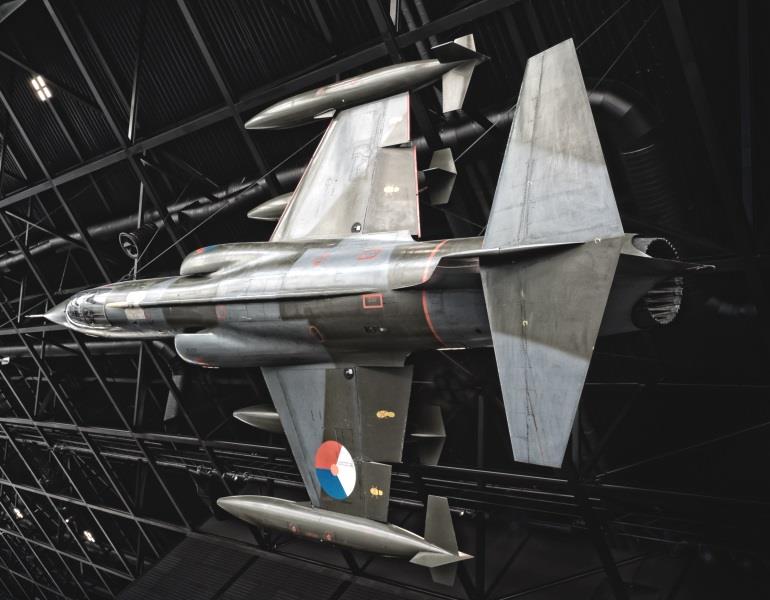
I have vague, fuzzy memories of Starfighters streaking over my head at low level when I was stationed in Germany in the early 1970s. It is a bit frustrating to feel like I had an experience once that I have now lost. I do have a vivid memory, however, of standing in the motor pool on a cold crisp winter's day watching what was almost certainly two Starfighters having it out at high altitude, one on the run, the other streaking up in its tail to make an attack while we GI below took in the contrails marking their paths.
* I've been tinkering with learning the Japanese language -- I don't recommend that anybody try doing this themselves -- and when one Japanese contact told me that JASDF Starfighters were called "maru-yon", I played detective with my dictionaries to figure out the exact translation. The answer turned out to be elaborate and interesting from a cultural point of view.
One of the complications in the Japanese language is that when, long ago, the Japanese acquired the Chinese character set, they also acquired the Chinese words that went along with them in addition to the traditional Japanese words. This means that as a general rule a single Chinese-style character has two readings, a Chinese-derived "ON" reading and a Japanese-derived "KUN" reading, or more broadly Japanese words typically have alternate forms. This is of course true to a degree in other languages, but the Japanese language takes it to an extreme.
In addition, since the Chinese and Japanese languages are not otherwise closely related, many words that sound differently in Chinese phonetics ended up sounding the same in Japanese phonetics, and so the language has a lot of words that sound the same but have completely different meanings and have to be understood in context. Other languages certainly have such "homophones", but Japanese also takes it to a (confusing) extreme. It's a good language for puns. The word "maru" can mean "merchant vessel" -- STAR TREK fans will be familiar with the space liner KOBAYASHI MARU -- but obviously that wasn't the right reading here. The actual meaning was "round", effectively like saying "oh" for "zero"; "yon" is the KUN reading for "four", so that means "maru-yon" equates to "oh-four".
However, Japanese also use the ON reading for "four", which is "shi". The problem is that "shi" is also the ON reading for "death", and nobody wanted to call the Starfighter the "oh-death". This is one of the first things a gain, a foreigner, learns about Japanese culture; I recall a samurai story that involved a band of four assassins who called themselves "shi" as a grim joke. Giving someone a gift of four items is tactless and can be used as an oblique insult. Since the ON readings are Chinese-derived, "four" is also unlucky in China.
My contact confirmed my thinking, and added that his flying club had two aircraft whose serials included "4". He wouldn't fly them.
* Sources include:
As always, there were discrepancies between sources, particularly for details of the configuration of different Starfighters and for numbers of aircraft built or flown by particular air arms.
* Illustration credits:
* Revision history:
v1.0.0 / 01 dec 04 v1.0.1 / 01 sep 05 / Review & polish. v1.0.2 / 01 aug 07 / Review & polish. v1.0.3 / 01 jul 09 / Review & polish. v1.0.4 / 01 jun 11 / Review & polish. v1.0.5 / 01 apr 13 / Review & polish. v1.0.6 / 01 mar 15 / More CCV details. v1.0.7 / 01 feb 17 / Review & polish. v1.0.8 / 01 jan 19 / Review & polish. v1.0.9 / 01 dec 20 / Review & polish. v1.1.0 / 01 jan 23 / Illustrations update.BACK_TO_TOP
